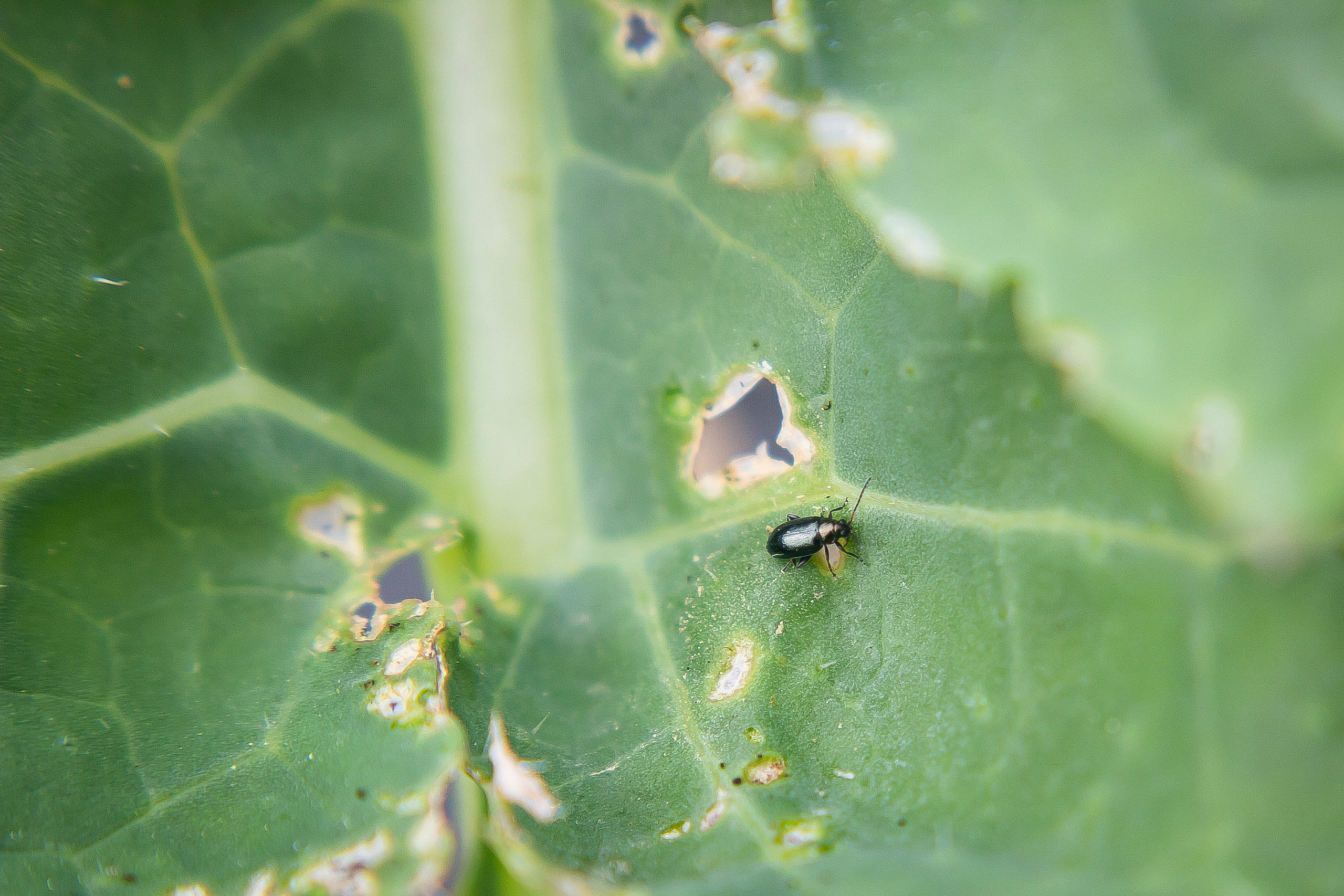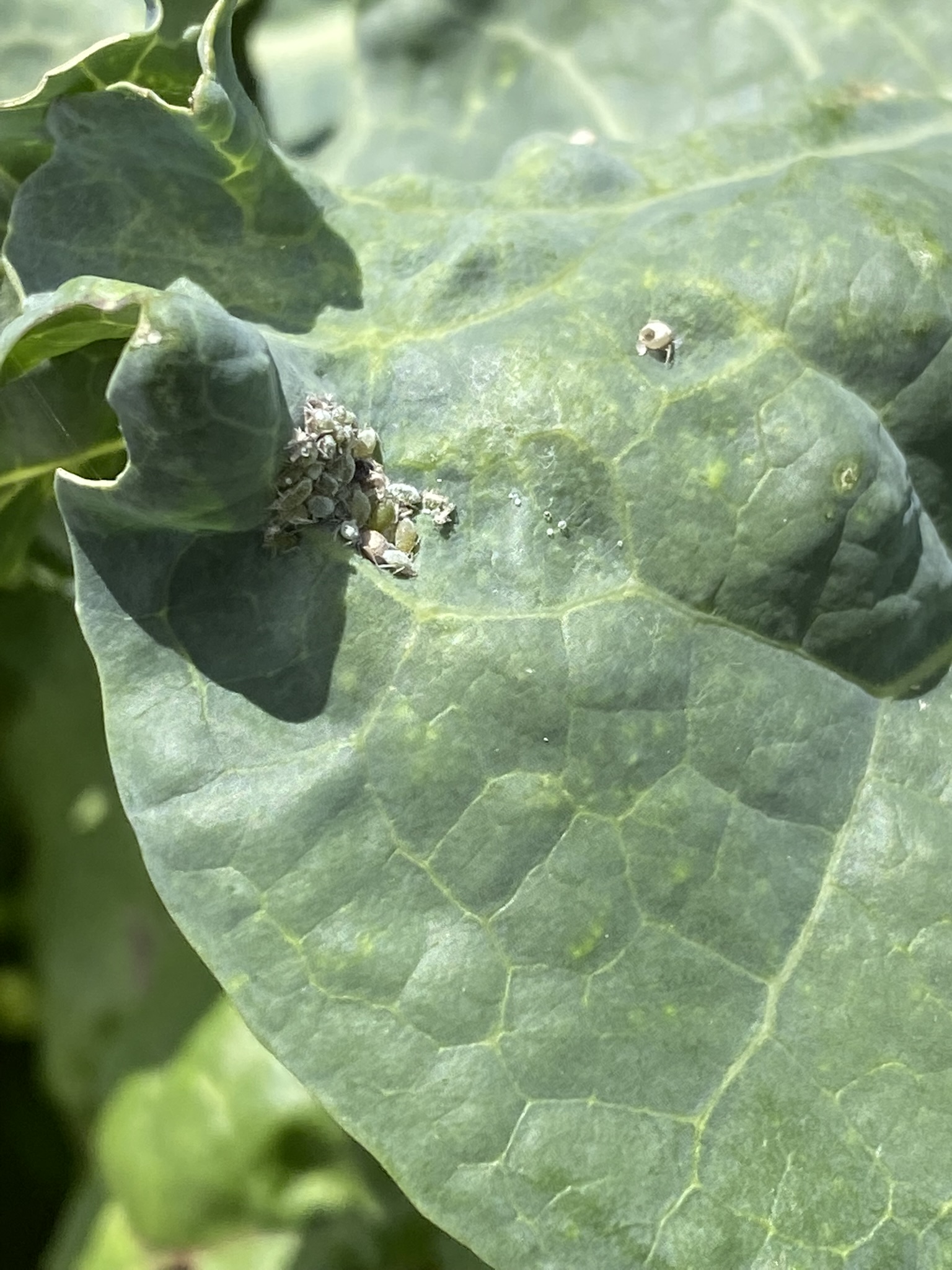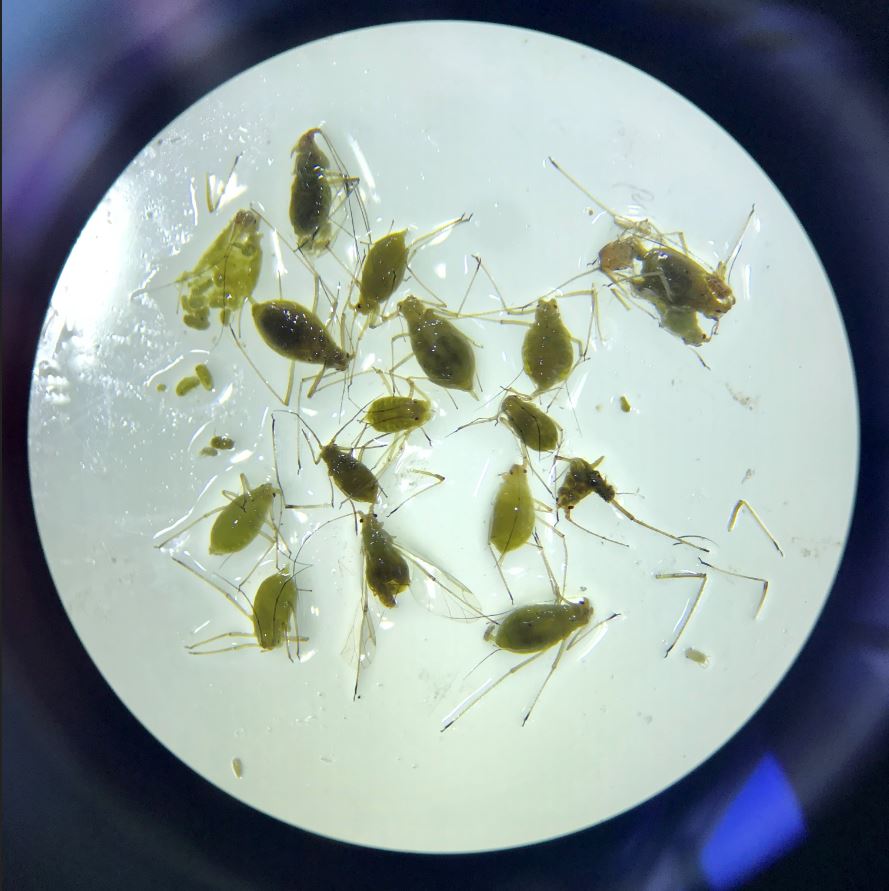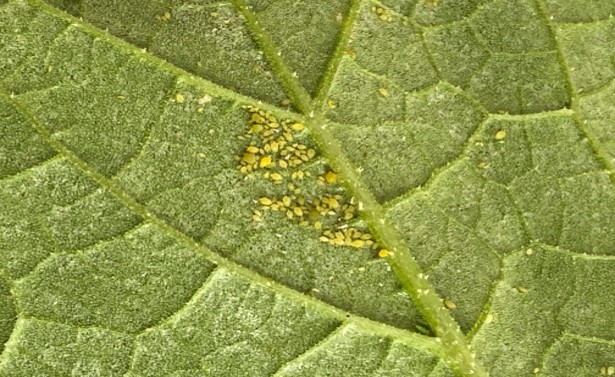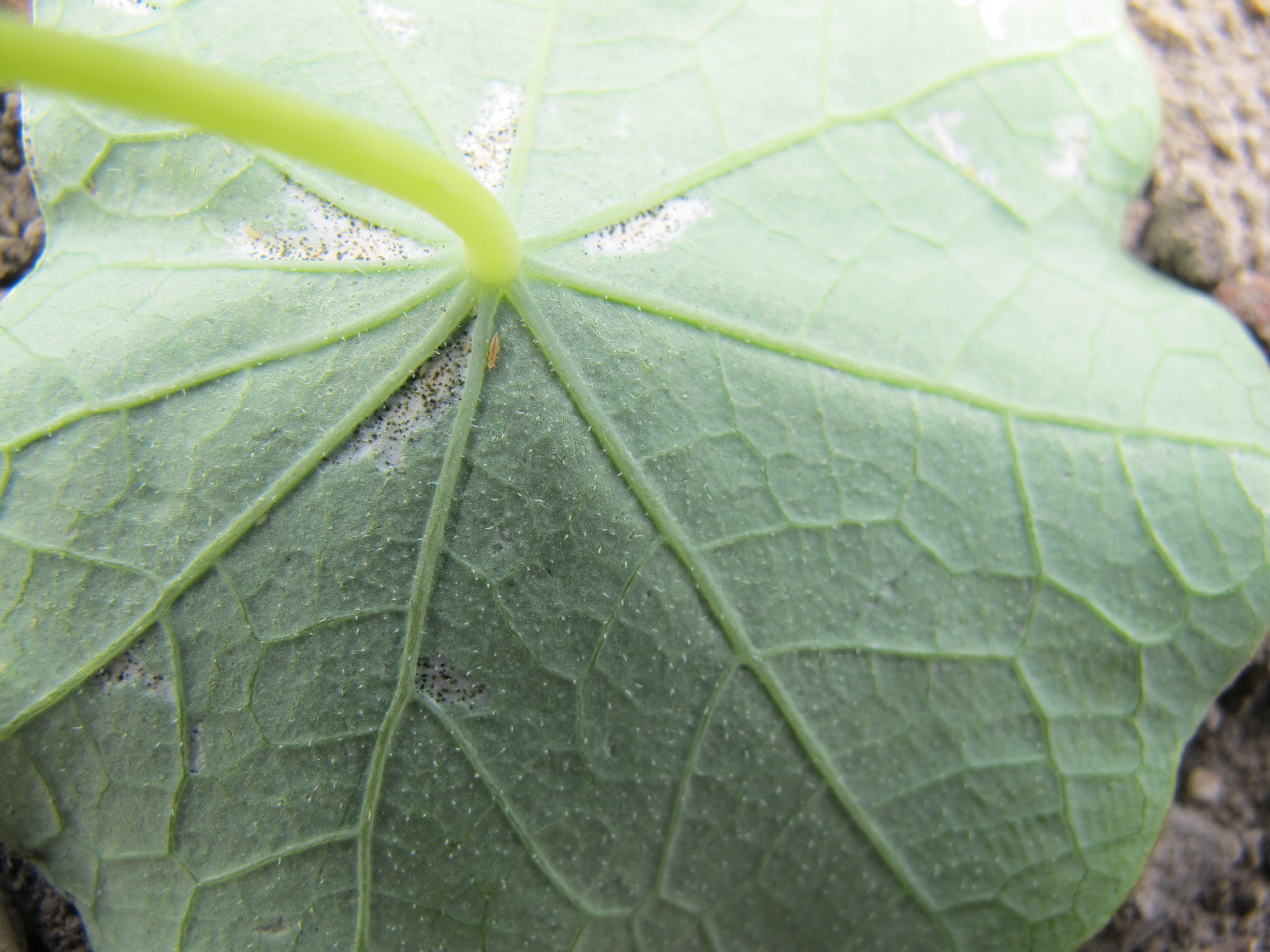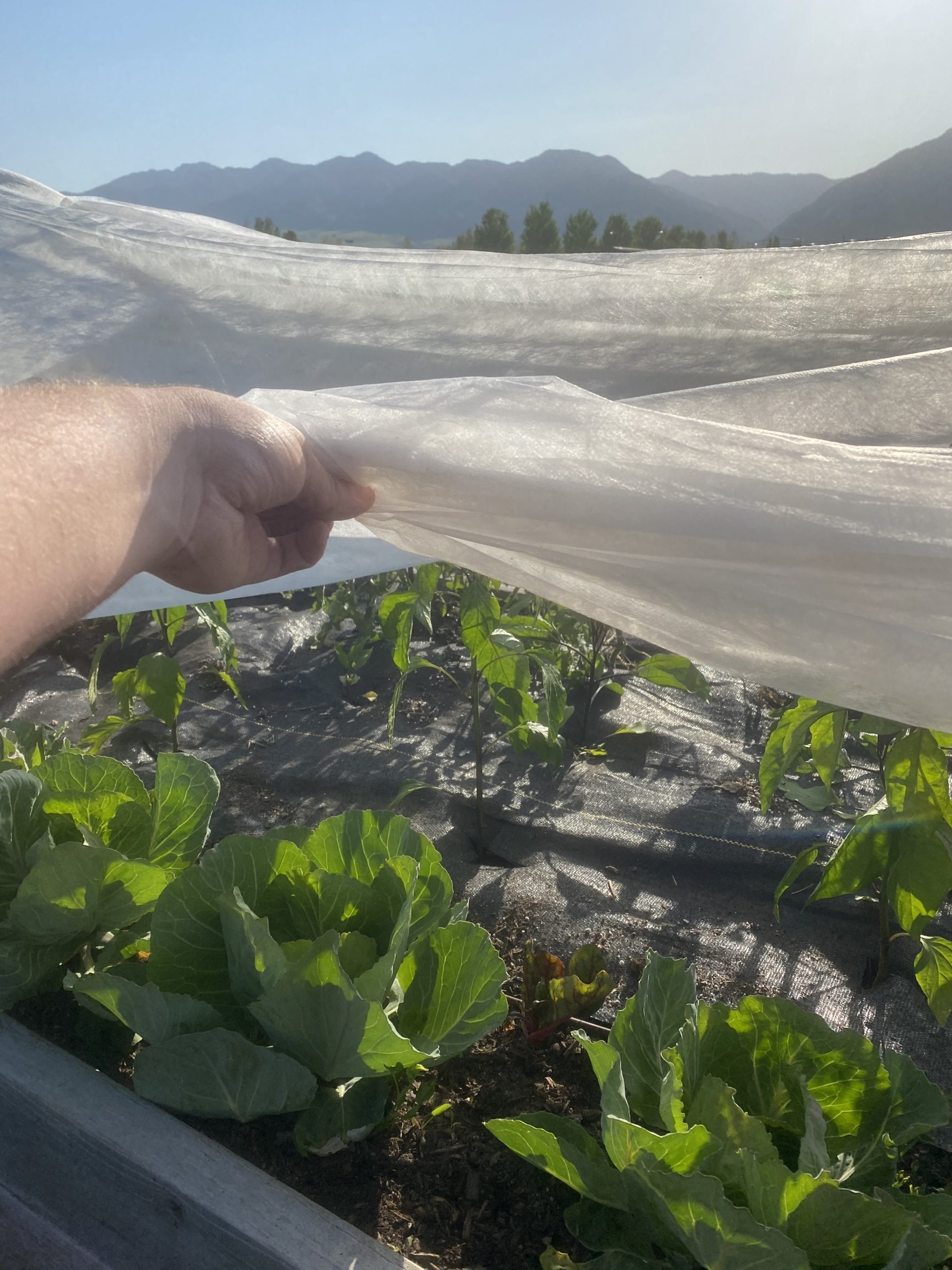In this Issue
- Crucifers: Flea Beetles, Cabbage Loopers, Diamondback Moths, Cabbage Aphids
- Solanaceous Crops: Green Peach Aphids
- Cucurbit Crops: Melon Aphids
- All: Thrips, Earwigs
- Production Information: Using row covers for pest control
CRUCIFEROUS CROPS
Kale, Broccoli, Cabbage, Brussels Sprouts, Kohlrabi, Cauliflower, etc.
Flea Beetles
Flea beetles can be very problematic throughout Utah’s vegetable crops. The crucifer flea beetle (Phyllotreta cruciferae) has notably been very destructive to plants in the Brassicaceae family.
Identification:Adults are small beetles measuring about 2-4 millimeters in length. They are usually shiny black or dark brown in color and have enlarged hind legs for jumping. Look for small, round holes in the leaves caused by adult beetles feeding. The larval stage may feed on the roots, causing stunted growth and wilting (this is rarely observed in Utah).
Management:
- Crop Rotation: Practice crop rotation by avoiding planting cruciferous crops in the same location for consecutive years. This breaks the beetle’s life cycle and reduces their population. This method tends to mostly be effective for large scale crucifer production.
- Physical Barriers: Use floating row covers or insect netting to create a physical barrier around young plants. This prevents adult beetles from reaching the plants and laying eggs.
- Mulching: Apply a layer of organic mulch around the base of plants. This can deter egg-laying females and make it difficult for emerging larvae to reach the soil.
- Trap Crops: Plant trap crops such as radishes or mustard greens around the main crop. These crops attract the beetles, and you can remove and dispose of them along with the beetles, reducing the population on the main crop.
- Biological Control: Encourage natural predators and beneficial insects in your garden, such as ladybugs, lacewings, or parasitic wasps, which feed on flea beetles.
Chemical Control: If infestations are severe and other methods have not been successful, you may consider using chemical insecticides labeled for flea beetle control. Organic options can include horticultural oils or insecticidal soaps. Always read and follow the instructions and safety guidelines provided by the manufacturer.
Click here for home-use products
Click here for commercial-use products
Cabbage Loopers
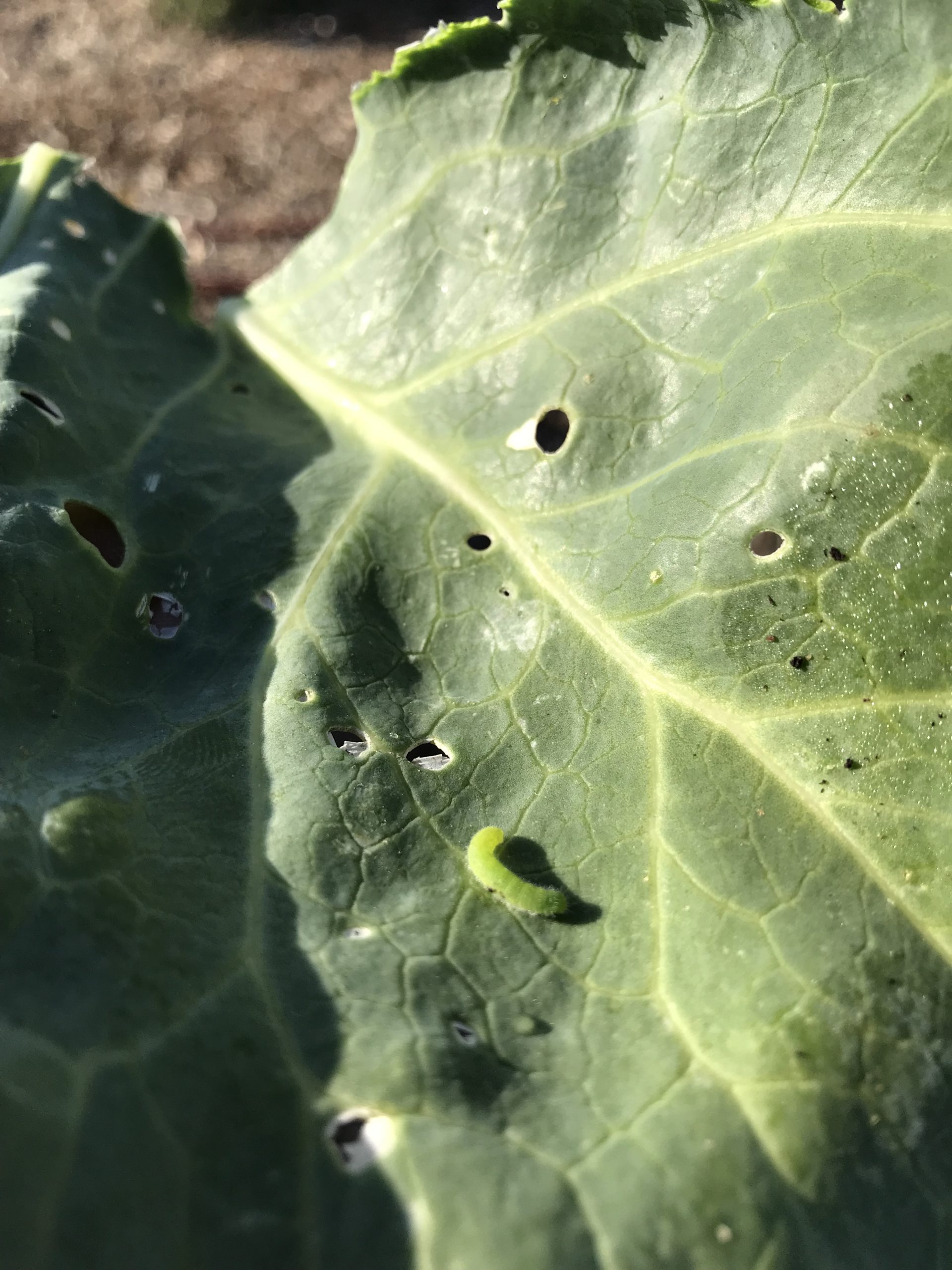 Trichoplusia ni, commonly known as the cabbage looper, is a pest insect that feeds on a wide range of plants, including cabbage, broccoli, lettuce, and other cruciferous and leafy greens.
Trichoplusia ni, commonly known as the cabbage looper, is a pest insect that feeds on a wide range of plants, including cabbage, broccoli, lettuce, and other cruciferous and leafy greens.
Identification: The larval stage is a medium-sized caterpillar with a green or brownish-green body. It has three pairs of true legs at the front and several pairs of prolegs along the abdomen. The caterpillar moves by arching its body and extending forward, creating a looping movement, which gives it the common name “cabbage looper.” The larvae feed on the foliage of plants, creating irregular holes or chewing damage on leaves. Adult moths have a wingspan of approximately 3 to 4 centimeters. They have a slender body and narrow wings. The forewings of the cabbage looper moth are mottled and typically vary in color from pale brown or gray to greenish-brown. The hindwings are lighter in color and usually plain or slightly mottled. The adult moths are nocturnal and are attracted to lights. They are agile fliers and can be seen fluttering around plants and garden areas during the night.
Management:
- Handpicking: Inspect your plants regularly and manually remove any cabbage loopers you find. Drop them into a bucket of soapy water to kill them.
- Natural predators: Encourage natural predators such as birds, lacewings, ladybugs, and parasitic wasps, which feed on cabbage loopers. You can also introduce biological control agents like beneficial nematodes, which may specifically target cabbage loopers.
- Row Covers: Use floating row covers or insect netting to physically exclude cabbage loopers from accessing your plants.
- Crop Rotation: Practice crop rotation by avoiding planting cruciferous and leafy greens in the same location for consecutive years. This helps break the life cycle of cabbage loopers and reduces their population. This method tends to mostly be effective for large scale crucifer production.
- Pheromone Traps: Set up pheromone traps to monitor adult cabbage looper moths and determine their population levels. This can help you anticipate and take action before significant damage occurs.
Chemical Control: If infestations are severe and other methods have not been successful, you may consider using chemical insecticides labeled for cabbage loopers. Organic options include products with the active ingredients spinosad, horticultural oil, or Bacillus thuringiensis (Bt). Be cautious and follow the label instructions and safety guidelines provided by the manufacturer.
Click here for home-use products
Click here for commercial-use products
Diamondback Moths
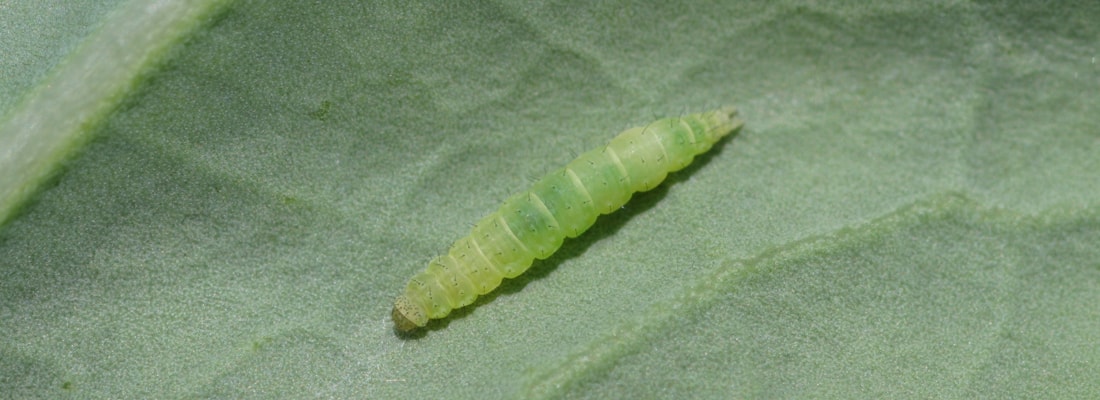 Plutella xylostella, commonly known as the diamondback moth, is a significant pest of cruciferous crops throughout Utah. It primarily affects plants such as cabbage, broccoli, cauliflower, and other members of the Brassicaceae family.
Plutella xylostella, commonly known as the diamondback moth, is a significant pest of cruciferous crops throughout Utah. It primarily affects plants such as cabbage, broccoli, cauliflower, and other members of the Brassicaceae family.
Identification: The adult diamondback moths are small, slender, and grayish-brown in color. They have a distinct diamond-shaped pattern on their wings, which is more noticeable when the wings are folded at rest. The larvae (caterpillars) of diamondback moths are green and about 1 cm long when fully grown. They have a tapered shape and can be easily distinguished by two rows of small, dark spots on each side of their body. The larvae feed on the foliage, creating irregular, ragged holes in the leaves. They often leave behind a trail of silk and excrement, which can be seen on the surface of the leaves.
Management:
- Handpicking: Handpick and destroy any larvae or eggs found on plants. This can be effective for small-scale or localized infestations.
- Natural enemies: Encourage natural enemies of diamondback moths, such as parasitic wasps, predatory beetles, and birds, by providing habitat and avoiding broad-spectrum insecticides that harm beneficial insects.
- Monitoring: Regularly inspect your plants for signs of diamondback moth infestation, including feeding damage and the presence of larvae or adult moths. Pheromone traps can be used to monitor adult moth activity.
- Row Covers: Use floating row covers or insect netting to physically exclude diamondback moths from accessing your plants.
Chemical control: If infestations are severe and other methods have not been successful, insecticides labeled for diamondback moth control can be considered. Use them as a last resort and follow the instructions and safety guidelines provided by the manufacturer. Target the early stages of the diamondback moth life cycle (eggs and young larvae) for optimal control, as they are more susceptible to management efforts.
Click here for home-use products
Click here for commercial-use products
Cabbage Aphids
Brevicoryne brassicae, commonly known as the cabbage aphid or brassica aphid, is a pest insect that infests cruciferous plants, including cabbage, broccoli, cauliflower, and other members of the Brassicaceae family. They are very common throughout the summer in Utah.
Identification: The cabbage aphid is a small soft-bodied insect, measuring about 2-3 millimeters in length. The adults can vary in color, ranging from pale yellowish-green to gray or black. They have pear-shaped bodies with long antennae and cornicles (small tubes) projecting from the rear of their bodies. Cabbage aphids tend to congregate and feed in clusters on the undersides of leaves, especially near the growing points of the plants. As they feed, cabbage aphids secrete a sticky, sugary substance called honeydew. This can attract ants and promote the growth of sooty mold on the leaves.
Management
- Early Detection and Prevention: Regularly inspect plants for signs of aphid infestation, such as curled leaves, yellowing, or sticky residue. Early detection allows for prompt action to prevent population buildup.
- Natural enemies: Encourage natural enemies of aphids, such as ladybugs, lacewings, syrphid flies, and parasitic wasps, by providing habitat and avoiding broad-spectrum insecticides that harm beneficial insects.
- Spray water: Use a strong stream of water to physically dislodge aphids from the plants. Repeat this process as needed.
- Reflective Mulch: Place reflective mulch around the base of plants to deter aphids from landing and moving up to the leaves.
Chemical Control: If infestations are severe and other methods have not been successful, insecticides labeled for aphid control can be considered. Organic options include insecticidal soap, horticultural oils. Organic options include insecticidal soap, horticultural oils. Be cautious and follow the label instructions and safety guidelines provided by the manufacturer.
Click here for home-use products
Click here for commercial-use products
SOLANACEOUS CROPS
Tomato, Pepper, Eggplant, Potato, Tomatillo, etc.
Green Peach Aphids
Myzus persicae, commonly known as the green peach aphid, is a pest insect that infests a wide range of plants, including solanaceous crops such as tomatoes, peppers, and eggplants. It is one the most common aphid species found throughout Utah.
Identification: The green peach aphid is a small soft-bodied insect, measuring about 2-4 millimeters in length. The adults are typically pale green, but can vary in color from yellowish-green to pinkish-brown or even dark green or black. Green peach aphids can have both winged and wingless forms. The winged forms have clear wings and are more mobile, while the wingless forms tend to cluster and feed on the undersides of leaves. Green peach aphids often congregate and feed in dense clusters on young leaves, shoots, and flower buds of plants. Similar to other aphids, green peach aphids produce honeydew, a sticky substance, as they feed. This can attract ants and promote the growth of sooty mold on leaves.
Management:
- Early Detection and Prevention: Regularly inspect plants for signs of aphid infestation, such as curled leaves, yellowing, or sticky residue. Early detection allows for prompt action to prevent population buildup.
- Natural enemies: Encourage natural enemies of aphids, such as ladybugs, lacewings, syrphid flies, and parasitic wasps, by providing habitat and avoiding broad-spectrum insecticides that harm beneficial insects.
- Spray water: Use a strong stream of water to physically dislodge aphids from the plants. Repeat this process as needed.
- Reflective Mulch: Place reflective mulch around the base of plants to deter aphids from landing and moving up to the leaves.
Chemical Control: If infestations are severe and other methods have not been successful, insecticides labeled for aphid control can be considered. Organic options include insecticidal soap, horticultural oils. Be cautious and follow the label instructions and safety guidelines provided by the manufacturer.
Click here for home-use products
Click here for commercial-use products
CUCURBIT CROPS
Melons, Cucumbers, Winter Squash, Summer Squash, etc.
Melon Aphids
Aphis gossypii, commonly known as the cotton aphid or melon aphid, is a pest insect that can infest cucurbit crops such as cucumbers, melons, squash, and pumpkins.
Identification: The cotton aphid is a small soft-bodied insect, typically measuring around 1-2 millimeters in length. The adults can vary in color, ranging from pale yellow or green to dark green or black. Melon aphids have a pear-shaped body with long legs and antennae. They have cornicles (small tubes) at the rear of their bodies. Melon aphids can have both winged and wingless forms. Winged forms have clear wings and are capable of flying, while the wingless forms cluster and feed on the undersides of leaves. Melon aphids tend to congregate and feed in dense clusters on the undersides of leaves, especially near the growing points of plants. Like other aphids, cotton aphids produce honeydew, a sticky substance, as they feed. This can attract ants and promote the growth of sooty mold on leaves.
Management:
- Early Detection and Prevention: Regularly inspect plants for signs of aphid infestation, such as curled leaves, yellowing, or sticky residue. Early detection allows for prompt action to prevent population buildup.
- Natural enemies: Encourage natural enemies of aphids, such as ladybugs, lacewings, syrphid flies, and parasitic wasps, by providing habitat and avoiding broad-spectrum insecticides that harm beneficial insects.
- Spray water: Use a strong stream of water to physically dislodge aphids from the plants. Repeat this process as needed.
- Reflective Mulch: Place reflective mulch around the base of plants to deter aphids from landing and moving up to the leaves.
Chemical Control: If infestations are severe and other methods have not been successful, insecticides labeled for aphid control can be considered. Organic options include insecticidal soap, horticultural oils. Be cautious and follow the label instructions and safety guidelines provided by the manufacturer.
Click here for home-use products
Click here for commercial-use products
ALL VEGETABLE CROPS
Thrips
Thrips are small, slender insects that can cause damage to vegetable crops. They feed by puncturing the plant tissue and sucking out the cell contents, which can result in distorted growth, silvering or bronzing of leaves, and reduced crop yield.
Identification: Thrips are tiny insects, usually measuring about 1-2 millimeters in length. They have elongated bodies and narrow wings, which are fringed with hairs. Thrips can vary in color depending on the species, but common colors include yellow, brown, or black. Some thrips may have banded or mottled patterns. Thrips feed by scraping the surface of leaves and sucking out the plant sap. This feeding damage can lead to the characteristic silvering or bronzing of leaves. Thrips are capable of flying and can be easily dispersed by wind or movement.
Management:
- Cultural Practices: Implement good cultural practices to minimize thrips infestations. This includes removing and destroying weed hosts and alternate hosts, as thrips can often feed on nearby weeds. Proper plant spacing and adequate ventilation can also reduce thrips populations.
- Reflective Mulch: Place reflective mulch around the base of vegetable plants to deter thrips from landing and feeding.
- Exclusion: Use insect netting or row covers to physically exclude thrips from reaching the plants. Ensure that the netting is tightly sealed to prevent thrips from entering.
- Biological Control: Encourage natural predators and parasites of thrips, such as predatory mites, lacewings, ladybugs, and minute pirate bugs. These beneficial insects can help control thrips populations. Avoid broad-spectrum insecticides that harm beneficial insects.
- Regular Monitoring: Regularly inspect plants for thrips and their damage. Shake plants gently and observe for any thrips that may fall onto a white surface. Sticky traps can also be used to monitor thrips populations.
Chemical Control: If infestations are severe and other methods have not been successful, insecticides labeled for thrips control may be considered as a last resort. Organic options such as neem oil or pyrethrin-based products, can provide control of thrips. Follow the instructions on the product label and use caution when applying around beneficial insects. Ensure thorough coverage, especially on the undersides of leaves where thrips tend to hide. Follow the instructions on the product label.
Click here for home-use products
Click here for commercial-use products
Earwigs
European Earwigs (Forficula auricularia) can be very problematic for Utah’s vegetable crops.
Identification: Earwigs are elongated insects, typically measuring about 1 to 3 centimeters in length. They have long, slender bodies with pincer-like appendages at the rear, called cerci. Common earwigs are usually dark brown or black in color, but they can vary in appearance. The characteristic feature of earwigs is the pair of curved pincers (cerci) at the end of their abdomen. These pincers are used for defense and mating, but they are not harmful to humans.
Management:
- Cultural Practices: Implement good cultural practices to minimize earwig populations. This includes removing debris, mulch, and excess vegetation around the crop area where earwigs can hide. Tilling the soil can expose and disturb their hiding places.
- Habitat Modification: Remove or reduce potential hiding places for earwigs, such as piles of garden debris, rocks, and boards. Regularly clean up the garden area to minimize their shelter options.
- Traps: Place dampened rolled-up newspaper or cardboard traps near the base of the affected plants in the evening. Earwigs will seek shelter in these traps during the day, allowing you to collect and remove them manually.
Chemical control: If earwig populations become excessively high and cause significant damage, insecticides can be considered as a last resort. Use insecticides labeled for earwig control, following the instructions and safety guidelines provided by the manufacturer. Remember to consider the potential impact on beneficial insects and the environment.
PRODUCTION INFORMATION
Using Row Covers for Pest Control
Row covers are an effective method for pest control in vegetable gardens. They create a physical barrier that prevents pests from reaching the plants, reducing the need for chemical insecticides. Here’s how to use row covers for pest control:
- Timing: Install row covers early in the growing season, preferably at planting or shortly afterward, before pests become a problem. This will prevent pests from establishing themselves on the plants.
- Prepare the Site: Clear the planting area of weeds and debris before installing row covers. Ensure that the soil is well-watered and fertilized as needed.
- Select the Right Type of Row Cover: Choose a row cover material that is appropriate for the pests you want to control. Lightweight fabrics are effective against small insects like aphids and flea beetles, while heavier fabrics or fine mesh netting can protect against larger pests like cabbage worms or squash bugs.
- Install Supports: Place sturdy supports along the row to provide structure for the row cover. This can be done using hoops, wire, or PVC pipes arched over the row. Make sure the supports are firmly secured in the ground.
- Measure and Cut the Row Cover: Measure the length of the row and cut the row cover material to the appropriate size, leaving some excess length on each end for securing.
- Position the Row Cover: Carefully drape the row cover over the supports, making sure it is centered along the row. Ensure that the row cover extends all the way to the ground on each side to prevent pests from accessing the plants.
- Secure the Row Cover: Anchor the row cover to the ground using soil, rocks, or other heavy objects along the edges. This will prevent pests from crawling underneath. Alternatively, you can use clips or pins specifically designed for row covers to secure the edges.
- Provide Ventilation: If the weather is warm or if the plants require pollination, provide ventilation by raising the edges of the row cover or leaving gaps for air circulation. Use clips or weights to hold the edges up or insert stakes to prop the cover open.
- Monitor and Maintain: Regularly check the row cover for any damage, tears, or signs of pests. Repair or replace damaged sections as needed. Water and fertilize the plants as usual, taking care to avoid excessive moisture buildup under the row cover.
- Remove the Row Cover: Once the threat of pests has passed or the plants require pollination, remove the row cover carefully. Store it properly for future use, ensuring it is clean and dry before storage.
By using row covers for pest control, you can protect your vegetable crops from a wide range of pests while promoting healthy and productive plants.

